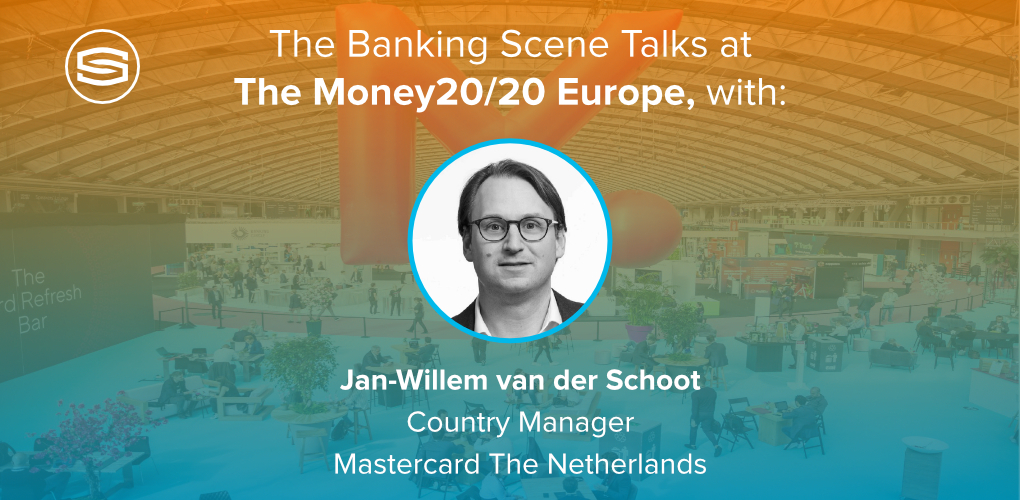
Insights & Opinions
The Banking Scene Talks at Money 20/20 EU, with Jan-Willem van der Schoot, Country Manager Mastercard The Netherlands
Mon, 08 Aug 2022


Money 20/20 Europe is unique in so many aspects. One is that it is the perfect occasion to talk to the shakers of industry and learn how they do things differently. We spoke to Jan-Willem van der Schoot, Country Manager of Mastercard The Netherlands. Besides being The Banking Scene Conference Amsterdam's main sponsor in 2022, they are one of the biggest shakers of The Netherland's payments industry, and at the forefront of change today with solutions like Click-to-Pay, tokenisation services and Debit Mastercard.
Click-to-Pay, tokenisation, and Debit Mastercard are top priorities for Mastercard today. Looking back on my days as a product manager at a bank 3-4 years ago, these topics are not new. Compared to then, what has changed in the market that will make these innovations a success today?
Jan-Willem van der Schoot: The pandemic shook consumers' needs in terms of payments. Whereas their Maestro card worked perfectly to buy a cup of coffee, once they shifted from buying offline to online, the limitations of the debit card became apparent.
Maestro was never designed for the current digital world. Debit Mastercard is much better suited for this, which is why we decided to gradually replace Maestro by Debit Mastercard. Not just in The Netherlands, but also in Belgium, Germany and many other countries. This was a conscious choice, because the worldwide acceptance of Debit Mastercard also ensures that people who travel across the border no longer experience problems in terms of acceptance, like with Maestro.
This is an important step to have one payment solution for a hybrid world, both online and offline, especially in combination with Click-to-Pay and tokenisation solutions.
Jan-Willem van der Schoot: We now have a payment solution that is fit for today’s world. Ever since the launch of Maestro 30 years ago, the magnetic stripe phased out and we learned to pay by chip. Later, we adopted contactless payments via Fitbit and other wearables, and today, consumers have embraced mobile payments.
Things evolved into an increasingly seamless payments experience and consumers expect nothing less than this in the online world. That is why solutions like card-on-file, where you securely store your debit payment information, are so important. Uber, Netflix and other similar service providers no longer accept having their services limited to credit card users, nor does the consumer.
To achieve solutions like these that fit today's world, in my opinion you need four conditions.
You need a brand that can support it, Mastercard in this case. You need a proposition that allows you to pay and to be paid. You need the maximum level of security, which is why we invest so much in tokenisation to support Apple Pay, Click-to-Pay and other innovations. Last but not least, you need to use regulation to optimise the payment flow to maximise the merchant and consumer experience.
Indeed, and it needs to be future-proof, of course.
Jan-Willem van der Schoot: Absolutely. If you look at how long past innovations defined the standard in payments, there is no doubt that these developments will set a new standard for many more years to come.
What’s more is that, because many of these solutions are digital developments, we have much more agility to adapt, update and upgrade them whenever needed. Together with the use of EMVCo standards on the chips, we believe that we can keep being a trusted partner for consumers, issuing banks and merchants.
Do you think these developments will also accelerate the evolution to more embedded payments, where payments are integrated into customer journeys to make the payments experience even more seamless?
Jan-Willem van der Schoot: Indeed, thanks to these developments, embedded payment solutions are no longer limited to credit card holders and early adaptors of open banking. Suddenly, consumers can add their token everywhere possible.
4G ignited new developments like Uber, Netflix and the likes. I am excited to see what our current developments will bring in a future with 5G and Internet of Things. IoT as such is not new, of course, but tokenised services in a 5G network make building IoT-based value propositions much easier in a secure manner.
You could think that payment innovations are adopted slowly, but don’t forget that 10 years ago, we paid with a magnetic stripe. This morning I paid for my train with an OV Chip card. Next year, I can pay for that with my Debit Mastercard or my phone.
Imagine what the world looks like in 10 years?
Take tokenisation, for example. My Fitfit token can easily be managed in my Fitbit app, but the token in my ring keychain is preloaded. In the future, my car will have a token; my phone will have one; maybe even my refrigerator.
All this needs to remain manageable for consumers. It requires a dashboard to keep trust in these innovations.
As a consumer, I have direct debits with all kinds of suppliers, but I have no overview that clearly shows with how much and which suppliers. My credit card details are stored for all kinds of providers like Netflix, Spotify... but I have no clue who actually has access to my card details.
To overcome this, we provide a Token Control solution that can be embedded in a banking app to list for the customer where all its tokens are stored, including activation and deactivation whenever needed, in real-time.
We believe these control mechanisms are a prerequisite to gaining consumers' trust and will lead to even more use cases to ease the life of consumers and our partners in a world of embedded payments.
Or how Mastercard reinvents itself to remain a relevant global payments player in the future.
Jan-Willem van der Schoot: The company was founded in 1966. Only a few companies achieved to exist for so long as Mastercard did. We were a Fintech “avant la lettre” through innovation, collaboration and reinvention.
We grew through collaboration, like we still do today. Whether in the context of crypto, open banking, or improving Mastercard payments flows, we always do it through partnerships.
We achieved to solve a chicken-and-an-egg problem by building a network that issuers and acquirers are using. This network is our biggest asset, and if we can keep strengthening this asset, I see a bright future for Mastercard.